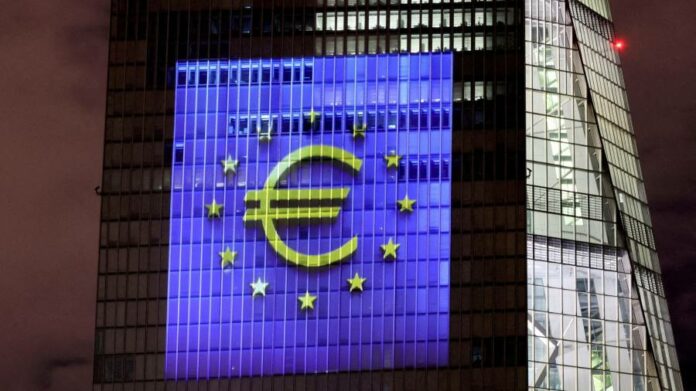A US banking crisis is unlikely to deter the European Central Bank from increasing eurozone borrowing costs this week, but analysts expect rate-setters to be more reluctant to commit to another rise in May.
The collapse of Silicon Valley Bank on the back of the sharp rise in US interest rates has sent shockwaves through markets. It has also raised questions about whether financial stability risks will stop central banks from raising rates much further.
The ECB has already said it intends to raise borrowing costs by half a percentage point when its governing council meets in Frankfurt on Thursday. Most economists expect it to go ahead with that move to lift its benchmark deposit rate to 3 per cent despite sharp falls in European bank stocks on Monday.
What the collapse of SVB is likely to diminish, however, is the appetite of ECB policymakers — including its president Christine Lagarde — to commit to raising rates by a specific amount at its next policy meeting in May.
“SVB’s collapse may prove to be a catalyst for a more cautious approach from central banks,” said Frederik Ducrozet, an economist at Switzerland’s Pictet Wealth Management, predicting that Lagarde would “strike a hawkish but non-committal tone on Thursday”.
“The ECB will not back away from the 50 basis point rate rise they plan to do this week,” said Holger Schmieding, chief economist at German investment bank Berenberg. “They will probably suggest there are more rate hikes to come without saying if they will be 25 or 50 basis points to give themselves time to see how this plays out.”
The failure of SVB has revived fears that the sharp rise in borrowing costs will increase stress in parts of the financial industry. An ill-judged UK government budget last year sent bond yields soaring and forced the Bank of England to restart bond purchases.
Analysts think the problems in the US banking sector are unlikely to be replicated in Europe. But ECB supervisors were on Monday checking lenders’ exposure to interest rate risk and the Bundesbank convened a crisis team that it created after Lehman Brothers collapsed in 2008.
European bank shares fell on Monday as investors fretted that the crisis may spread beyond the US. Several European lenders suffered double-digit share price falls including Spain’s Banco Sabadell and Germany’s Commerzbank, while the Stoxx banking index dropped 7 per cent.
In contrast, bond markets rallied — sending borrowing costs sharply lower — as investors sought the relative safety of government debt while reassessing how much further central banks will tighten monetary policy now the risks to financial stability have been laid bare.
Erik Nielsen, chief economics adviser at Italian bank UniCredit, said the SVB collapse was “a perfect example of the trouble with pre-announcing policies”, as the ECB did following its meeting in early February. There was “no obvious reason why the US mess should spread to Europe,” he said, predicting the ECB would raise rates by half a percentage point this week as anything less would “raise a lot of eyebrows”.
Tensions have been intensifying between ECB rate-setters over how much further it should raise rates. Austrian central bank governor Robert Holzmann has called for four more half point rate rises, but Italian central bank boss Ignazio Visco criticised this approach, calling for prudence.
Uncertainty about ECB policy puts extra importance on its publication of the latest quarterly forecasts, due to be released on Thursday. The projections, which show what the ECB thinks growth and headline inflation will be this year, next year and 2025, will provide vital pointers on how quickly it might stop raising rates.
In December, the central bank said it expected eurozone inflation to hit 6.3 per cent this year, 3.4 per cent in 2024 and 2.3 per cent in 2025. All three forecasts were above the its 2 per cent target — a clear indication that policymakers believed they needed to raise rates further.

But since then wholesale gas prices have more than halved to €49 per megawatt hour, based on Dutch TTF gas futures contracts for the coming month, the European benchmark.
Adding to the downward pressure on prices, European banks have already raised lending rates and tightened borrowing conditions significantly, which should reduce the flow of credit and lower demand. The SVB collapse could make banks even more conservative, squeezing financing conditions further and reducing the need for the ECB to raise rates.
Economists have already downgraded their inflation forecasts for the rest of this year, and most think the central bank — which in December estimated gas prices would average €124/MWh this year — will follow suit for the first time since December 2020.
However, some ECB watchers believe the stickiness of underlying price pressures will make it harder to justify cutting its forecasts for 2024 and 2025. Core inflation, which excludes energy and food prices and is a better indicator of longer term pressures — hit a record high last month.
Morgan Stanley economist Jens Eisenschmidt predicted the ECB would cut this year’s inflation forecast to 5.8 per cent. Yet he said stronger core inflation in 2023 “likely means” it will raise its price growth forecast for 2024, while the impact of recent rate rises in reducing activity would lead to a lower figure for 2025.
A resilient economy, rising wages, a boost to corporate profit margins and the delayed feed-through of last year’s energy shock to other sectors could all keep core price pressures elevated — maintaining the pressure on the ECB to keep raising rates for at least a few more months.
Katharine Neiss, an economist at the investor PGIM Fixed Income, said: “Our view remains that core inflation will continue to rise until late spring, as previous energy price rises push up on non-energy goods and services with a lag.”
The ECB declined to comment. But Lagarde said recently that while headline inflation would fall rapidly from March, core prices would “be stickier in the near term”.






